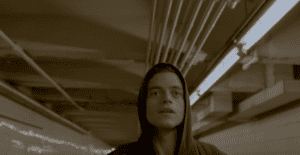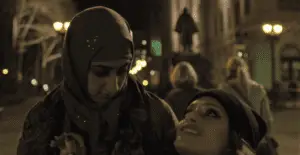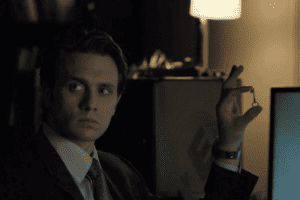A slight man wearing a hoodie, wide-eyed, wracked with anxiety but assured in what he’s about to do, reveals he’s going to expose a child pornography dealer – not for blackmail, but for justice. Then he pulls up his hood and blends into the crowd. The opening scene of Mr. Robot, which I sat down to catch up on in 2016 as Season 2 started to air, had me hooked from the get-go. Rami Malek’s acting as Elliot Alderson was the hook: TV critics took serious notice, and so (eventually) did the Emmys.
After the hook, several other things sealed my fate of obsession with this show, the brainchild of Sam Esmail, who wrote and directed most of the series. There was the supporting cast including interesting women and LGBTQ characters; the open acknowledgement of the evils of modern capitalism; the surreal and foreboding atmosphere; the exploration of drug abuse and mental illness; the music … oh, the music.
In the very first episode, a mysterious figure offers Elliot a role in the hack of a lifetime, a hack that, by erasing debt, could crack and crumble the edifice of capitalism causing so much malaise in Elliot’s world. It is dangerous; it is crazy. But the temptation is overwhelming. As Elliot walks through the streets and subway tunnels, contemplating the choice, Neil Diamond’s version of “If You Go Away” plays — melancholy minor key about a love about to be lost, swelling into major-key hope and possibility on the hypothetical about the lover not leaving:
But if you stay, I’ll make you a day
Like no day has been or will be again
We’ll sail on the sun, we’ll ride on the rain
We’ll talk to the trees that worship the wind

I was stunned at the use of this love song, the hit-you-in-the-gut emotions of the will-you / won’t-you-stay trope, to express the feeling of Elliot’s choice. The chance to destroy capitalism represented as a forbidden lover. Reader, I was a goner. This was my show. I was obsessed. I would marry it. I would think about this show every day, I would defend it to the death, I would never leave its side.
Intense infatuations can develop in a couple of different ways, whether we’re talking about love affairs with TV shows or with people. They may smooth themselves down into a deeper, more sustainable love. Or they may burn out. I thought I was in it for the long haul with Mr. Robot, but my ardor started to cool sometime in Season 3. Now, after the concluding Season 4, I am signing the divorce papers. I’m sorry, Mr. Robot. I truly loved you once. But you weren’t the TV show I thought you were.
Spoilers for Mr. Robot beyond this point. Content warnings for discussion of violence and sexual assault/abuse.
Gender and queerness in Mr. Robot: fridged promises
Mr. Robot consciously acknowledges Fight Club as a major reference point, and Elliot Alderson immediately invited comparisons to archetypal angry young men, Holden Caulfield and beyond. Holden Caulfield is certainly one of Elliot’s narrative ancestors – “everyone’s a phony” and “we’ve all been indoctrinated into corporate culture, to Instagram photos and buy Starbucks” are variations of the same message. But if this had been merely another angry-young-man story, I would not have loved it like I did. Mr. Robot went far beyond that trope.
First, Elliot was a pretty different person than your standard Caulfield. The character was, and was played by, a man of color. His upbringing was middle class, but more characterized by outright abuse rather than the neglectful, disapproving wealthy parents that are sketched out in many of these stories. Elliot was not just a misfit because of existential ennui; he suffered from serious mental illness and a morphine addiction.
And, to me, at least in the first two seasons, Elliot’s gender and sexuality had enough ambiguity to make him resonate deeply. He embodied less of a male-specific story, and instead a more accessible portrait of alienation and suffering than any of his forebears, Holden Caulfield or Tyler Durden or even Donnie Darko. Part of it was Elliot’s skinny, goth-y androgyny, part of it the way his body was frequently shown subject to malfunction and violation (sweaty and shaking from opiate withdrawal; getting beat up) which complicate typical heteromasculinity. Sex was presented, in Season 1, as something that just sort of happened to Elliot – he didn’t have a lot of sexual agency. Elliot deliberately distanced himself from dudebro culture. He didn’t have any illusions of out-macho-ing other men threatening him; he had to find other ways to survive and retaliate. Plus, of course, the show pulled no punches with sexual tension between Elliot and a canonically bisexual male character, Tyrell Wellick.
For these reasons, queer viewers, including and maybe especially nonbinary and asexual viewers, could see themselves in Elliot. In the book Red Wheelbarrow that accompanied the TV show and presented events just prior to the start of Season 2, further gender trouble was hinted at in Elliot’s dream of being in a gathering of loved ones. All the men were in one room in his dream, all the women in another, and he was standing between the rooms feeling confused which one to go to, but warm and content that everyone was there. Not exactly a subtle metaphor — at least to those of us standing between those rooms.

The second thing that made Mr. Robot much more than another Fight Club iteration was the supporting characters. Carly Chaikin’s Darlene was a deeply believable character: a tough punk with hidden vulnerabilities, complicated emotions about leadership of the hacker group F Society, and nuanced relationships with other characters – notably her fellow hacker, Trenton, played by Sunita Mani. Though a minor character, Trenton was an audience favorite. An Iranian-American whose motivation in the hack was to free her immigrant parents from the slavery of their financial debt, we don’t see a lot of people like her on TV. Another major woman character, Angela, played by Portia Doubleday, at first glance appeared to be a prim conformist and an innocent. However, bit by bit she was revealed to be a tough schemer, and deeply involved in the hackers’ revolutionary plans. Other women characters, like Shayla, Joanna Wellick, and Dominique “Dom” DiPierro also had compelling arcs on the show.
Mr. Robot also had a lot of LGBTQ representation. In addition to Tyrell Wellick, Shayla, Angela, and Darlene were all revealed to be bisexual. Trenton was unrequitedly in love with Darlene. Dom was a lesbian, and her later relationship with Darlene was explored in depth. Whiterose, a trans woman who headed the mysterious hacker collective the Dark Army, was an intriguing character through much of the show, though the choice to cast B.D. Wong, a cis-male actor, as Whiterose was problematic. A number of compelling minor characters were also queer, including Elliot’s sometime boss Gideon, and Carla, a trans woman with no speaking part in Season 2 but who factored heavily into Red Wheelbarrow (and who Elliot had a mad crush on, despite Reddit fanboys’ insistent denial of this. I guess they think that love poem he wrote her was a “just buds” thing.) All this to say that Mr. Robot started out of the gates as one of the queerest shows on TV.
Unfortunately, the show systematically killed off a hell of a lot of these characters.
I was willing to forgive the show for the death of Shayla in Season 1 – another deeply believable, vulnerable, interesting woman character. I mourned this character, but her death did fit with the plot. Also, Rami Malek’s acting when he discovered her body was impressive, showing a long moment of dissociation before his emotional reaction hit him.
But as the deaths racked up, it became increasingly clear that Mr. Robot had a serious combination fridging / bury-your-gays problem.

More severe spoilers follow…
By the end of Season 2, Gideon was dead, and Trenton and her associate, Mobley, seemed not long for this world (although we had to wait for deep into Season 3 to watch them die). Again, these deaths moved the plot along. But then they just started to get weird. Stephanie Corneliussen as Joanna Wellick had stolen the screen as a Lady Macbeth-esque figure, goading her husband Tyrell to achieve power, and helping him cover up a murder he’d committed (another minor woman character offed for no apparent reason in Season 1; I was hoping at the time that her death served some larger purpose, but apparently it was just to show us how much of a psycho Tyrell was.)
In Season 2, when the audience thinks Elliot is meeting Joanna for the first time, Joanna made clear signs of being already acquainted with Elliot. This gave further evidence for a past relationship between Tyrell and Elliot, or one of his personalities (unbeknownst to Elliot), and also hinted at Joanna having knowledge of F Society and the hack her husband was involved in. I was expecting to find out more, including what Joanna thought of her husband’s obsessive love of Elliot. But in Season 3 Joanna kicks it, and not because of any shady hacker stuff or murder-covering-up she’s doing – she is just shot by an angry ex-lover. And that was it for Joanna. What a waste.

Meanwhile, Angela followed a common trope of a woman descending into madness. She gets duped into helping carry off a terrorist act causing a massive number of deaths, by being enticed into believing in Whiterose’s sci-fi vision of alternate realities. What exactly Whiterose showed her in the penultimate episode of Season 2 (in a creepy, surreal scene where Angela is seemingly questioned by her own younger self) that made Angela into a true believer, we never quite find out. But Angela pays the price, obsessing over the deaths she caused, complete with wallpapering her apartment walls with photos of the dead.
And then Angela meets her end in the opening minutes of Season 4, with a deliberate lack of fanfare: she is literally in the background of the shot, far in the distance behind a distraught Phillip Price, when Dark Army agents put a bullet in her head. The elegant cinematography did not outweigh the slap in the face that this central character was offed so casually. I know, I know, we’re supposed to be horrified at the cold-blooded way the Dark Army takes care of problems. But, in context of all the other women and queer characters this show casually killed off, this scene didn’t raise my ire at the fictional Dark Army, but rather at the real-life creator of the show, Sam Esmail. I had trusted Esmail’s vision. My trust was already wavering in Season 3; as Angela’s body fell to the ground in the Season 4 opener, my trust was in pieces.
I was willing to give the show Angela’s Season 3 mental breakdown – it followed naturally from her personality and the consequences of her actions – but the show overdid this trope, depicting Whiterose losing it in the show’s conclusion as well. Whiterose, who throughout the show had been calm and cool-headed in the extreme, was hysterical in her final scene, and killed herself – again without a lot of fanfare or even much reaction from Elliot, the only other character present, (who, to be fair, had other things distracting him in that moment). It is implied that Whiterose believes she will live on in the alternate reality she has built or accessed in the Washington Township Facility, but this is never clearly spelled out. Another woman character lies dead in a pool of blood. At that point, I wasn’t even surprised.
At least Dom and Darlene make it out of some harrowing situations alive, which was a small comfort; their budding relationship ended in a heartbreaking last-minute decision sending one of them to another continent. Had Esmail killed off one or both of this pair, I would have thrown a heavy object at my TV screen, so I’m thankful for small favors.
Finally, the gender and sexuality ambiguity hinted at in Elliot was not only never followed up on, but more or less erased in the final season of the show. For unexplained reasons, Elliot and his alter-ego Mr. Robot sort of switched roles in the final season, with Elliot pushing for dangerous schemes and Robot trying to hold him back and do less damage to peoples’ lives. Elliot suddenly was engaging in much more heteronormative behavior, seducing a woman he needed information from (he is seen climbing on top of her, in an out-of-character display of sexual agency), and foolishly pulling a gun on a group of men who have kidnapped him.
I never expected a reciprocated Tyrelliot to be made canon, but I did expect more flashbacks of interactions that the Mr. Robot personality – or one of Elliot’s other personalities – had had with Tyrell. Their past relationship, blocked out of Elliot’s memory, was heavily teased in the first two seasons, and then basically dropped. “Did you ever even care about me?” Tyrell does beg Elliot in their extended hike through snowy woods in the final season: Tyrell’s obsessive love for Elliot was allowed to remain. Elliot, however, makes it crystal clear that, no, he never cared. Fic writers can squint and still find room for a sexual relationship between the two in the past – especially involving one of Elliot’s other identities – but the show firmly refused to give any more hints, catering to the dudebros in the audience.
Mysteries solved disappointingly, hints left hanging
Mr. Robot was a show full of mysteries and twists, starting with “Who is Mr. Robot?”, the show’s initial advertising tagline. There were a couple of large reveals in Season 1, including the answer to the tagline, and also one major one in Season 2.
These reveals were well-executed and satisfying. However, I was even more interested in the overarching mysteries of the show, the ones woven into the theme of the show and the fabric of the characters. Foremost among these mysteries, to me, was the timelines of Elliot’s identities. Where exactly was his mind?
Early in Season 1, Elliot has a drug-withdrawal-induced hallucination which includes visions of Tyrell and Angela each holding a key. The vision of Angela tells Elliot that he has only existed for a month. Put together with the knowledge that Elliot suffers from dissociative identity disorder (D.I.D.), this seemed like a pretty huge hint that the personality we saw on-screen was very new. Was “Mr. Robot” actually the original Elliot?

Not so – in later seasons, we saw flashbacks showing what looked like the development of the Mr. Robot identity. Hints of that personality came through in a flashback with Elliot and Darlene spending Halloween together, and also in a flashback where Elliot, as a child, is at the movies with his dad. Were these red herrings? Or were we seeing the beginnings of Mr. Robot coming forth? In which case, the obvious question was: Who was the original Elliot? Whoever he was, it was implied in the withdrawal vision that Angela and Tyrell held the metaphorical keys to unlocking the secret of his interconnected personalities.
In the height of my obsession with this show, I developed a theory that the original Elliot was an amalgam of Mr. Robot and the Elliot we knew, and that, prior to the events of Season 1, he had split his mind in two deliberately somehow to achieve his hacker-revolution ends (ask me about the 20K-word fanfic I wrote exploring this idea.) It was nice and neat, and fit the tone of the show; I convinced some friends. I don’t mind being wrong. I just expected the talented writers of this show to have come up with something better than what I came up with, a fan and amateur, following their own clues. They kind of didn’t.
Elliot turned out to have several personalities, and the original Elliot had been trapped away in a mental fantasy world by the personality the viewers have come to know and love. The latter, our Elliot, is finally named in the final episode of the series: “The Mastermind”. Hence, this Mastermind is the one who has only existed for a month in Season 1. But so much is left unexplained. We don’t ever get a sense of what the original Elliot was like. He’s not the happy, half-formed guy from the mindworld he was trapped in; that was clearly a simplified, constructed environment. So then, maybe show us a flashback? One scene to show us who he was before he got trapped?
Other questions remain after this reveal. One that bothered me was, what was Elliot’s actual mother like? Clearly not the Stepford Wife caricature of the mindworld. But, the abusive mom of his memories, shown in flashbacks in earlier seasons, is revealed to have been a fabrication as well. This leaves an empty space for the Magda Alderson character in viewers’ minds. We never learn the reality of her, even while so much of the show revolves around Elliot’s father. Who was Mrs. Alderson?
What Elliot’s mother was really like might seem like a minor issue, but it takes on more importance considering another major reveal in the final season: that Elliot had been sexually abused by his father, which is tied to the development of his D.I.D. This plot development made sense, given that D.I.D. is frequently associated with a history of sexual abuse. Once again, Rami Malek’s acting was superb as Elliot struggled with the emotions of having to face a violent part of his past he had shut away. The Mr. Robot identity had been created to protect him from that past, to be the good father he never had. All this tracked.
But there was something off about the revelation. It occurred in a bizarre parody of a therapy session, held at gunpoint by Fernando Vera, Shayla’s murderer, who we hadn’t seen since Season 1. The return of Vera seemed a little forced. Further, the weird black-box-theater vibe of Season 4 episode 7, with its jarring, classic-gangster-film-music score, created the kind of surreal effect that, in previous seasons, had signaled that what was happening wasn’t quite real – Elliot’s hallucinations; his imagining of his mother’s house; the lovingly re-created 1980s sitcom of Season 2 episode 6. But this time, oddly, the events seemed to be occurring as shown; there were witnesses who responded to everything without Elliot’s presence.
Most disturbingly, to me, though, was how the show selectively put so much emotional weight behind Elliot’s (and Vera’s) history of sexual abuse, versus other characters. Contrast it with Vera’s casual mention of raping Shayla in Season 1 – and his even more casual assault of Krista, Elliot’s therapist, in the very episode where Elliot realizes his past abuse. Vera sliding his hand up Krista’s skirt was contextualized in the show as if it was just a threat of violence, as if doing that nonconsensually to a woman tied to a chair and gagged is not already violence. Oh, and then there’s all the women who got violently murdered, and the “mini-Angela” little girl who seems to be being abused, in Season 2 episode 11. These other incidents of violence were all treated with cool detachment, just part of the dark, menacing atmosphere of the show. It’s almost as though the writer’s room felt a lot more feelings about violence done to men than about violence done to women.
Oh, and the imagery of keys from season 1? These are finally “explained” in the final season as metaphorically unlocking Elliot’s memories of his sexual abuse. Angela’s connection to the key metaphor might be inferred, as she may have known about the abuse, being Elliot’s childhood friend. Tyrell’s connection to Elliot’s childhood memories? Who knows.

Lots of smaller mysteries, or intriguing potential clues, were never resolved. I mentioned Joanna Wellick’s seeming wider knowledge above. Lots of odd particulars that seemed to portend something never did. The show was especially keen on sexual details. Joanna was into BDSM but Tyrell was reluctant. Angela was bi, or at least experimented, making out with Shayla while on drugs. A drug dealer hits on Elliot, who responds a little ambiguously. Before she apparently knew he was cheating on her, Angela displayed such loathing toward her Season 1 boyfriend, Ollie, that I was convinced she was dating him mainly to help Cisco use him as a Dark Army mark. What were all these things for? Just to look cool, just add to the ambiance of the show? I feel naive about it now, but I believed things like this would be brought back, tied together.
Season 4 was a meta-reveal: It showed us the real priorities of the show. It wasn’t so much about mysteries, big ideas regarding the malaise of modern capitalism, or exploring character anymore; it was full-on Cinema de Dudebro. To my untrained eye, moment after moment in Season 4 smacked of film references that most of the audience wouldn’t get (the drawn back camera shot as Dom notices a traffic camera; a dying Tyrell finding something glowing blue inside a suitcase; whatever was happening with the music behind Vera’s speeches in episode 7…). References are fine if there’s real meaning behind them, multiple layers of analysis. But you started to feel like, by Season 4, the writers were bored with plot, character, and themes, and just wanted to have a film-nerd circle jerk together.

In the same vein, the show trolled its viewers in several ways in Season 4; instead of thoughtfully constructed twists, we got things like Elliot seeming to be drug-overdosed by a Sam Esmail cameo in the first episode – only for a final scene to run after the start of the credits, showing him being revived. And the biggest troll of all: the show never told us WTF was in the Washington Township Facility. We are to believe, I guess, that Whiterose’s vision, and all the geopolitical maneuvering she had accomplished throughout the series, were all in service of an insane fantasy. I liked the idea of ambiguity in Elliot’s exploration of his fantasy mindworld – was that a creation of his own head, or could it have been Whiterose’s alternate-reality simulation? But the show did nothing to highlight this ambiguity, leaving me to think that it wasn’t intended.
Heartbreak
Think back to 2015, when Mr. Robot Season 1 first aired. Our hearts were high. The day was young.
I fell in love with this show in Season 1, and stayed in love in Season 2. It carried me through some dark times. It whispered sweet promises in my ear, of sailing in the sun, of riding in the rain. I believed in its possibilities. I trusted a little too much in its very talented creators. But they are human, and in retrospect, the chances of their vision ultimately meeting all the hefty promises they made were always slim.
Alas, every love has an end – one way or another. In general, I very much approve of a show wrapping up in a planned, small number of seasons, and four is a number that seems to work pretty well most of the time. The Leftovers (three), The Good Place (four), and Crazy Ex-Girlfriend (four) are three notable examples of shows that benefited from individual season arcs embedded within an overall show arc, and satisfying conclusions. Still, you’re sad when a beloved show completes and you have to leave it.
And the other way a TV romance can die is that it lets you down in some kind of way. With a fifth season, Mr. Robot possibly could have found its conclusion at less of a break-neck pace, while exploring some of the mysteries and themes it dropped. We’ll never know.
Mr. Robot, you left me just enough love to fill up my hand. My disappointment is deep. But I’ll always remember our brief affair.

